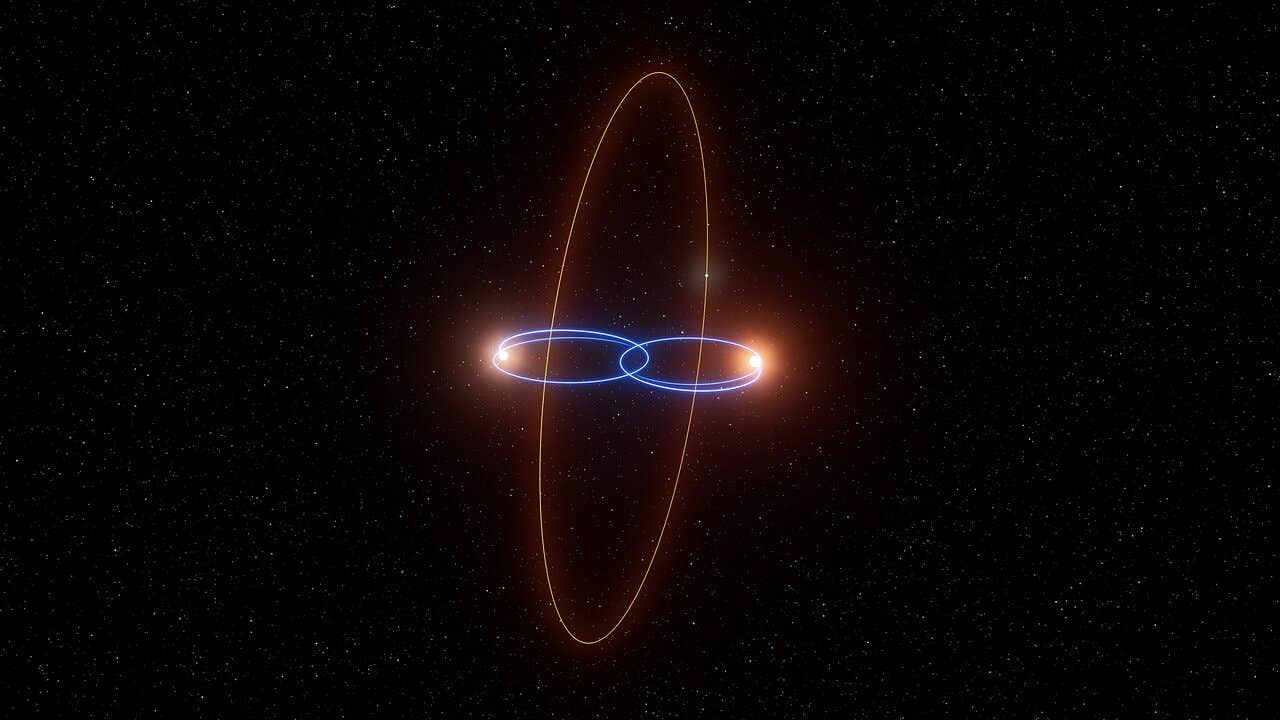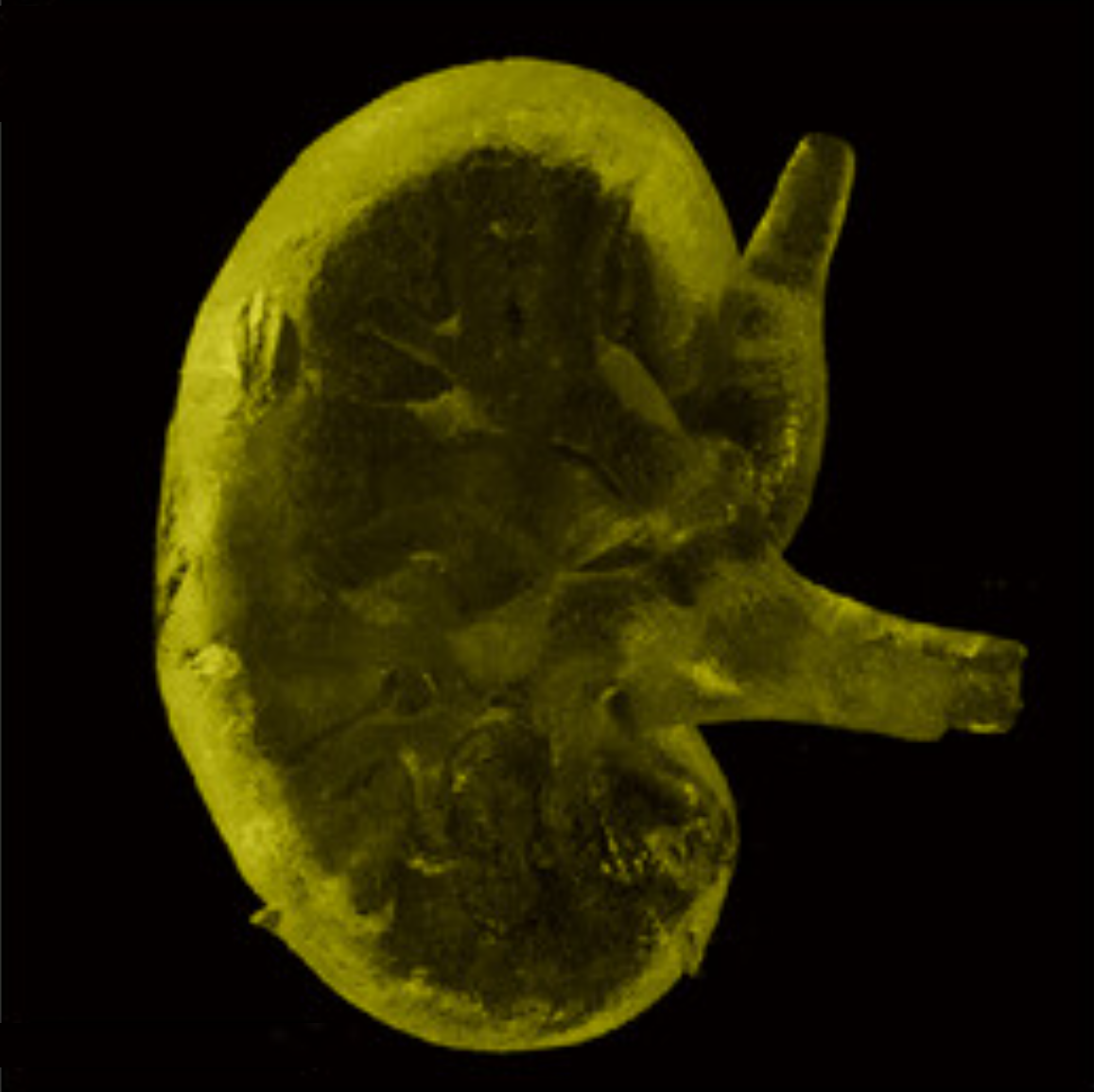Astronomers find rare planet orbiting at 90 degrees around twin brown dwarf stars
A planet circling at a sharp 90-degree angle to the orbits of its two host stars has now been confirmed. This discovery challenges long-standing ideas about how planets form and…

Artists impression of 2M1510 (AB) b, a planet in a perpendicular orbit around two brown dwarfs. (CREDIT: ESO/M. Kornmesser)
A planet circling at a sharp 90-degree angle to the orbits of its two host stars has now been confirmed. This discovery challenges long-standing ideas about how planets form and orbit in the cosmos. And it shows that space still holds many surprises.
The planet—named 2M1510 (AB) b—moves around a pair of brown dwarfs, which are celestial objects heavier than gas giants but not quite stars. These brown dwarfs form what is known as an eclipsing binary. That means they orbit each other in such a way that they pass in front of one another from Earth's viewpoint. What’s truly remarkable is that this planet’s orbit is nearly perpendicular to the orbital plane of its stars.
This rare planetary system is only the second known to contain an eclipsing pair of brown dwarfs. It's also the first known to host a planet that follows a polar orbit, spinning like a wheel around the axis formed by the motion of its two stars. The discovery has sparked fresh questions about how planets form and stay stable in such strange positions.
A One-of-a-Kind Discovery
The two brown dwarfs in question—together known as 2MASS J15104786-2818174, or simply 2M1510—were originally discovered in 2018. That detection came from the SPECULOOS project (Search for habitable Planets EClipsing ULtra-cOOl Stars), which is based at the Paranal Observatory in Chile.
These two brown dwarfs are almost equal in mass, each weighing just over 3% of the Sun’s mass. Their orbit takes about 21 days to complete and is notably elongated. They lie about 250 astronomical units from a third brown dwarf, making the system even more complex. Adding a planet to this picture only deepens the mystery.
The system belongs to the Argus moving group, a collection of young stars about 45 million years old. This makes the discovery especially valuable, as young binary brown dwarf systems like 2M1510 help scientists test and improve models of how such objects evolve.
Related Stories
The breakthrough came when scientists, using the Very Large Telescope (VLT) in Chile, analyzed the orbital paths of the two brown dwarfs. They detected slight irregularities—tiny pushes and pulls—that hinted at an outside force at work.
“We noticed the orbits of the two brown dwarfs around one another were being delicately affected,” explained Dr. Lalitha Sairam, now at the University of Cambridge. She developed a new data analysis method that improved measurement precision by a factor of 30. That precision made it possible to notice what others had missed.
Following a Polar Path
Normally, planets orbit in roughly the same plane as their host stars. Most of the 16 known circumbinary planets—that is, planets that orbit two stars—follow this coplanar rule. These were largely found by NASA’s Kepler and TESS space telescopes using the transit method, which spots dips in starlight as a planet passes in front of a star.
But 2M1510 (AB) b breaks that mold. This planet orbits perpendicular to the stars’ orbit—a configuration known as a polar orbit. For years, astronomers had theorized that such orbits could be stable, especially around binary stars with highly eccentric paths. And in some cases, gas and dust discs around such stars had been spotted in polar positions. Still, until now, no actual planet had been confirmed in such an orbit.
“We had hints that planets on perpendicular orbits around binary stars could exist, but until now we lacked clear evidence,” said Thomas Baycroft, a PhD student at the University of Birmingham who led the study. “We reviewed all possible scenarios, and the only one consistent with the data is if a planet is on a polar orbit about this binary.”
Baycroft’s team published their findings in Science Advances. Their research shows that the irregular motion observed in the 2M1510 system can be explained only by the presence of a third body: a planet tugging on the binary stars in just the right way.
This subtle influence—called apsidal precession—refers to a shift in the orientation of the stars’ orbit over time. It’s a bit like how Earth’s axis wobbles slightly over millennia. In this case, the precession is moving in reverse, or retrograde, a sign that only a polar orbiting planet could produce.
Why This Matters
The discovery of 2M1510 (AB) b offers more than just a new name for the exoplanet catalog. It forces scientists to rethink ideas about how planets form and where they can safely exist. Until now, most models assumed that planets formed in flat, spinning discs of gas and dust aligned with their stars. Polar orbits didn’t seem likely.
Yet, over the years, astronomers have spotted several polar gas and debris discs around binary stars. In one case, signs of dust growth suggested planet formation was already underway. Researchers had also suggested that stars merging in binary systems could throw off planets into polar paths.
But no one had yet seen a fully formed planet on such an orbit—until now.
“A planet orbiting not just a binary, but a binary brown dwarf, as well as being on a polar orbit is rather incredible and exciting,” said Professor Amaury Triaud, a co-author of the study from the University of Birmingham.
What’s more, this was not even the original goal of the team’s work. “The discovery was serendipitous, as our observations were not collected to seek such a planet,” said Triaud. “As such, it is a big surprise and shows what is possible in the fascinating universe we inhabit.”
New Tools, New Frontiers
The tools that made this find possible are part of a larger trend in astronomy. The radial velocity method—measuring tiny changes in a star’s motion due to the pull of an orbiting planet—is becoming more precise. In fact, this same method helped confirm three other circumbinary planets in recent years: Kepler-16b, TIC 172900988 b, and BEBOP-1c.
In each case, astronomers measured how a star’s motion wobbled due to the pull of a planet. In some instances, they even used the rate of apsidal precession to estimate a planet’s mass. These new techniques allow scientists to detect planets that don’t pass in front of their stars and are invisible to the transit method.
As the technology improves, astronomers expect to find more strange planets like 2M1510 (AB) b. Some may follow even more extreme paths, giving us new clues about how diverse planetary systems can be.
This discovery also underscores the value of curiosity-driven research. Baycroft and his team weren’t specifically hunting for polar planets. Yet their work has led to a major shift in how we think about planetary orbits.
And somewhere out there in the galaxy, perhaps on a far-off world, another observer may be watching their twin suns spin above—and wondering if their world is just as rare.
Note: The article above provided above by The Brighter Side of News.
Like these kind of feel good stories? Get The Brighter Side of News' newsletter.



